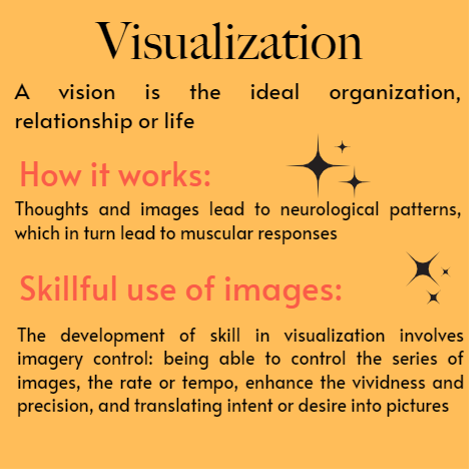
A vision can be a mental picture of an "ideal" organization, relationship or life. Studies have shown that we are more likely to reach an objective if we can see it and can imagine the steps to reach it. Visioning is a common strategy in sports. Olympic skaters imagine themselves going through the steps and landing a perfect jump.
Visual thinkers create pictures or models of a problem in their mind, play with the visual, move it around, refine it and use it to raise more questions. A drawing or model helps push thinking further. Albert Einstein imagined himself travelling through the universe as a "man in a box" on a ray of light. This vision helped him develop the theory of general relativity. Visualization is the art and skill of creating a mental model of an event or situation. It is controlled, directed and purposeful. Peak performers visualize more and better than others. They may have learned spontaneously to visualize events in vivid detail.
How Visualization Works
The body cannot distinguish between an event which is experienced and one which is vividly imagined. We cannot think or imagine without some level of physical response occurring. In visualization, thoughts and images lead to neurological patterns, which in turn, lead to muscular responses. With the repetition of a sequence of thoughts and images, in other words, a visualization, the associated pattern in the nervous system is strengthened and the responses that are imagined have a higher probability of occurring in the actual situation.
Skilful Use of Images
Visualization is different from internal narration or dialogue. Although words and thoughts can help to focus images, visualization involves primarily the use of mental images, not thoughts. Images or pictures are the primary content of visualizations because words cannot be generated at a fast enough rate to describe events as they occur. Visualization engages a different part of the mind than strictly rational, linear thinking. The development of skill in visualization involves imagery control: being able to control the series of images, the rate or tempo, enhance the vividness and precision, and translate intent or desire into pictures. Visualization is focused mental work that sharpens the real skills being viewed. By developing visualization skills, you can learn to construct visualizations that are powerful mental tools.
Click here to view a video that explains how to practice visualization.